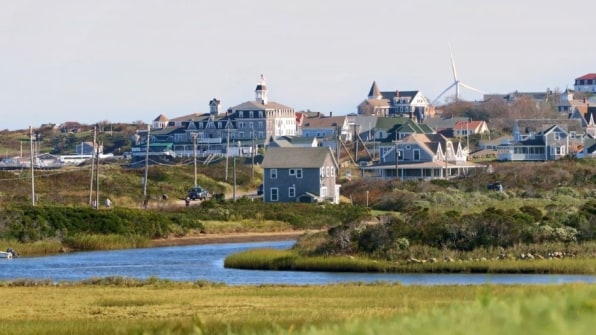Chris Bruce grew up in Michigan, and his first major job was in the automotive industry. He did prototyping work for around 14 years. “It was the biggest thing going on in Michigan,” he said. “It’s pretty much all there was.”
Until, during the Great Recession of 2008, it began to decline, and half the jobs in the industry disappeared. Bruce’s was one of them. “After I lost my job, I had about three days of sulking, and then I got up and decided to listen to some of my coworkers’ advice to look into wind turbines,” he said in Reinventing Power: America’s Renewable Energy Boom, a new film (to be widely released this summer) from the Sierra Club about the energy revolution in America. He now works as a turbine engineer, and the wind industry is helping the state climb out of its deep recession.
Bruce’s circumstances are not unusual: In the U.S., jobs in sectors that have traditionally boosted the economy are disappearing. Coal is environmentally damaging and expensive to mine. Car companies are looking at an eventual slow-down in sales. Across both sectors and many more, automation is putting people out of work.
Renewable energy is poised to step up where these older sectors are falling behind. Wind and solar employ over 800,000 people across the country, and are some of the fastest-growing industries. As these resources scale, they’re becoming economically viable–solar is around 50% cheaper than coal–and wide-scale adoption of wind and solar could help curb America’s carbon emissions. And they’re adaptable across a range of communities: Reinventing Power traces the establishment of the country’s first offshore wind farm near the tiny Rhode Island community of Block Island and delves into community solar programs in Austin and wind power on Northern Cheyenne Indian Reservation in Montana and a farm in North Carolina, The film also follows the retraining of former coal miners and auto workers for jobs in renewables throughout the U.S.
“A lot of the arguments you hear about clean energy are moral–like it’s the right thing to do,” says Brennon Edwards, CEO of Transit Pictures, which produced the film. “We wanted to go for something different, and show how renewable energy is revitalizing communities and revitalizing industries,” he adds. “There’s basically no political or celebrity attachment to it–these are just real Americans who are having this change affect their lives, and it’s happening all over the country.”

To find the array of stories to tell through the film, Edwards worked with the Sierra Club to reach out through its dozens of local chapters to find people whose lives were impacted by renewable energy. It wasn’t difficult: There were many stories that were similar because this is a widespread phenomenon, Edwards says: It was just a matter of selecting those stories that were particularly emblematic of the trend.
One overarching theme is that of farmers or landowners who are hosting renewable infrastructure on their properties. Horace Pritchard, a 68-year-old farmer who’s lived around Elizabeth City, North Carolina his whole life, was approached by Avangrid Renewables (which partnered with Amazon on the initiative) about establishing a wind farm on his property around 10 years ago. Some of his neighbors had concerns about noise and aesthetics, but for Pritchard, the collection of turbines has created negligible disruption on his land–he farms basically up to the edge of the turbines–and Avangrid Renewables‘s lease has granted him a steady income source. “If they want my whole farm, they can have my whole farm,” he said. Pritchard has heard from other farmers who’ve leased out their land to wind farms that the only problem they see with the turbines is that there aren’t enough of them.
Renewables also create benefits for small communities. On Block Island, for instance, the offshore wind farm has eradicated the community’s need to import diesel fuel via boat, and created a more consistent and affordable energy supply for the island. And for a community that’s dependent on tourism, the turbines have only helped boost interest in the region: because Block Island is the country’s first offshore wind development, people that visit the island now are as keen to see the turbines up-close as they are to tour the island’s quaint shops and shorelines.
“We’re telling the story of the clean energy revolution through the voices of the people who are benefitting from it,” says Mary Ann Hitt, director of the Sierra Club’s Beyond Coal campaign. “We wanted the viewers to be able to see themselves in these stories, because there’s still a lot of fear and anxiety around transitioning away from fossil fuels.” Reinventing Power comes on the heels of From the Ashes, a film featuring the Sierra Club’s work that Bloomberg Philanthropies and RadicalMedia released last summer about how coal communities are making the shift, and how renewables are playing a part in helping them diversify and grow. Communities can contact the Sierra Club to learn how to host grassroots screenings of the film to help residents see the positive repercussions.
In the current political climate, there’s a lingering rhetoric that renewable energy will deplete American jobs and weaken the industries that have supported the country in the past. But those industries are dying of their own accord, and renewables, Hitt says, are benefitting people in red states, rural areas, and those previously dominated by coal and oil, as well as major coastal cities. “Renewables will require us to rebuild the entire energy infrastructure,” Edwards says. “Our energy infrastructure is crumbling, and it has to be rebuilt one way or another, and this is happening regardless of politics.”
Fast Company , Read Full Story
(31)